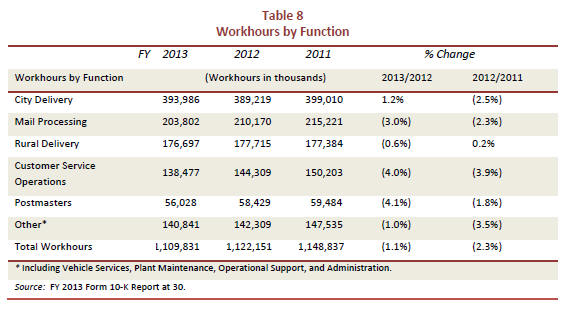Washington, DC – In a report released today, the Postal Regulatory Commission evaluates the Fiscal Year 2013 performance goals and Fiscal Year 2014 performance plans of the United States Postal Service. The Commission had in previous years provided this analysis in its Annual Compliance Determination report. However, the Commission has determined that issuing its analysis in a separate report allows the Commission to provide a more in-depth review of the Postal Service’s goals and plans than in previous years.
The Commission’s report addresses and makes suggestions related to the Postal Service’s four performance goals: 1) Service, 2) Customer Experience, 3) Financial Results, and 4) Workplace Environment. Below is a summary of the Commission’s findings.
- The Commission found that the Postal Service partially met the Service performance goal because it met some, but not all, targets for the service performance indicators. For presort First-Class Mail, all performance indicator targets were met. Single-Piece First-Class Mail performance results were mixed.
- The Service did not meet its Customer Experience performance goals for residential and small-medium businesses as measured by national surveys. While the Postal Service also surveys large business customers, those survey data are not used in assessing performance towards achieving the Customer Experience goal. To ensure that all customers’ needs are being considered, the Postal Service should include a customer experience performance indicator and target measure for large business customer experiences.
- The Commission determined that the Postal Service partially met its Financial Results performance goal. For FY 2013, deliveries per hour, which the Postal Service uses to measure productivity, did not meet the target. However, operating losses were less than forecast.
- In the fourth and final goal, the Commission found that the Postal Service partially met its Workplace Environment performance target. In FY 2013, its Occupational Safety and Health Administration’s Illness and Injury Rate of 5.61 met the performance target; however, the Voice of the Employee survey target was not met.
The Postal Service describes the growth in city delivery workhours as beneficial overall because newly hired 30,433 city carrier assistants resulted in lowering the overall cost of city delivery by $120 million.60 However, due to the simplicity of the DPH calculation and components, the increased workhours (regardless of the actual cost) in the denominator of the ratio contributed to the Postal Service not meeting its DPH target. The Commission remains concerned about using DPH as a meaningful financial performance indicator. The Commission finds that TFP is a better index because it measures the ratio of total workload to total resource usage.61
The Postal Service reports that “[t]he growth rate of new delivery points has slowed in recent years, compared to pre-recession levels, due to lower housing starts.”62 Despite an increase of 773,882 new delivery points in FY 2013, the Postal Service reduced the total number of routes by 1,847 (from 226,999 to 225,152).63
Workplace Environment
The Postal Service relies on two performance indicators to evaluate progress towards its performance goal of Workplace Environment. First, it uses the OSHA I&I Rate to measure improvements in safety. The OSHA I&I Rate is calculated by multiplying the total number of OSHA injuries and illnesses by 200,000 hours, which represents 100 employees working 2,000 hours per year.64 That number is then divided by the number of exposure hours worked by all employees. Id.
In FY 2013, the OSHA I&I Rate of 5.61 was better than the FY 2013 target of 5.72 and a 2.94 percent improvement over FY 2012. Id. at 39, 42. According to the Postal Service, the OSHA I&I Rate is also 15 percent better than the comparable private sector industry average rate of 6.60. Id. at 65. It reports that the reason for the decline in exposure hours was continued emphasis on safety process improvements, training, and correction of unabated hazards. Id. at 42. The target for FY 2014 is 5.55, which is better than the FY 2013 target. Id. at 39.
Second, the Postal Service relies on the VOE survey score, which measures employee engagement. The VOE survey provides Postal Service employees the opportunity to provide feedback on various areas of job satisfaction. Id. at 42, 63. VOE surveys are administered by a third-party vendor who tabulates the results and reports them back to the Postal Service in summary form. Id. at 63. The VOE survey score is based on eight VOE survey questions addressing: (1) strategic direction; (2) trust; (3) contribution to Postal Service growth; (4) communication; (5) diversity and respect; (6) commitment; (7) personal safety; and (8) work effort and quality.65 The Postal Service filed under seal the VOE survey questionnaire and summary statistics of the employee responses to each question.66
In FY 2013, the VOE survey score of 64.7 did not meet the FY 2013 target of 64.9.67 The Postal Service explains that one reason the target was not met may be the overall decline in morale among federal employees.68 It notes, however, that the results compare favorably to recent declines in satisfaction and culture indices seen in other federal sector surveys.69 The FY 2014 target is 65.1, which is higher than the FY 2013 target. Id. at 39.
Comments
The Public Representative asserts that the VOE survey does not focus on employee morale or views about management as it affects employees. Rather, he argues that the survey is based primarily on a few questions asked of a statistically significant proportion of employees about whether they believe the Postal Service is doing a good job. He contends that it is impossible to determine whether the measure of success showing improvement by two-tenths of a percentage point is anything more than within the margin of error.70
Commission Analysis
The Postal Service partially met the Workplace Environment performance goal. In FY 2013, it met the OSHA I&I Rate target, but not the VOE survey target. The VOE survey score remained constant at 64.7 in FY 2011, FY 2012, and FY 2013, which demonstrates that the Postal Service is neither improving nor declining in this area.71 The Postal Service must improve its VOE survey score and maintain its progress regarding the OSHA I&I Rate to meet the Workplace Environment performance goal.
The Commission has reviewed the VOE survey and finds that the responses to the questions in the survey are an appropriate measurement of employee morale and views about management. The Postal Service has the flexibility to determine which questions comprise the VOE survey.
In the FY 2012 ACD, the Commission recommended expanding upon sections of the FY 2013 Report that discuss the OSHA I&I Rate.72 The FY 2013 Report and FY 2014 Plan contain some discussion of the OSHA I&I Rate. Further information is provided in the FY 2013 Comprehensive Statement and in the Postal Service Response to CHIR No. 12, question 3.73
The OSHA I&I Rates in the FY 2013 Report differ from the OSHA I&I Rates reported in previous Annual Performance Reports. In the Postal Service’s FY 2010 Report,74 the OSHA I&I Rate presented showed that the Postal Service had met its target. Similarly, in the Postal Service’s FY 2012 Report, the OSHA I&I Rate presented showed that it had again met its target. However, in its FY 2013 Report, the Postal Service revised its reported OSHA I&I Rates for fiscal years 2010, 2011, and 2012. As shown below in Table 9, there is an increase from the originally reported rates. The data presented indicate that in both FY 2010 and FY 2012, the Postal Service’s OSHA I&I Rate was actually higher and it therefore would not have met either year’s target.
A complete copy of the Commission’s report can be found on the PRC website at www.prc.gov


The first two comments sum up the current postal reality. So, when are the RICO charges coming against the postal management ‘unions’???
Until the incompetent, stealing, unethical sleaze that infest eas/mgmt ranks are held accountable for their actions, nothing will change.
Totally agree about VOE. I toss mine out every time. If all employees did the same “maybe” someone would notice. I also think VOE participation is a category mgmt. can choose as part of their bonus program. They don’t care about the responses just that we respond.
A few points here need stressed. First, despite its claims otherwise, management could not possibly care less about service or “customer experience”. Supervisors and other management HATE talking to customers and answering the phone because they view those people as annoying and trouble makers. They have eliminated any semblance of accuracy and proper handling of the mail in their training of new carriers. CCA’s and rurals are not taught about mark-up mail (attempted not known, forward order expired, insufficient address, no such number, etc.) This means all the mail goes into a box with no knowledge of how to handle it if it doesn’t belong to that customer. They typically use any endorsement and just, in carrier terms, “kill” the letter so they don’t have to deal with it properly and as long as nobody complains, management doesn’t care. Nor are they encouraged or trained how to forward mail, or even look on address change cards at the carrier cases. Too much time, in management’s view. This means when you turn in an address change, it will go into a computer forwarding system but if for some reason that computer info is entered incorrectly, the new or lazy carrier will not know what to do with it when it’s returned to him or her to review.
More experienced carriers know to resubmit the change of address to correct it, and mail that is not forwardable is handled properly into each relevant endorsement. Even we vets get badgered sometimes to hurry and forget about this mail, but we do what we have to do anyway. Does that sound like management is concerned about accuracy or reliability? It’s all run run run, the hell with safety and dependability.
Second, the VOE is a crock of shit from the first question. Management really pushes it, but the questions are posed in ways that are so nebulous and ambivalent that they are ultimately useless. Plus, there are no real questions about real working conditions, like, the death traps they call LLV’s, management abuse, failure to do their job so we can do ours, and other issues upper level jerks don’t want to know about. It’s all softball crap, easily twisted and distorted so management can interpret them however they see fit.
I throw my VOE survey in the trash. Nobody in management could give a rat’s ass less what a lowly single cell life form like a craft employee thinks.